
The Russian invasion of Ukraine continues to impact global security, challenging standard principles of defence planning and national strategy. Middle powers, whether they be close to the aggression, like Poland, or far from it, like Australia, have been reminded of the looming threat of increasingly assertive autocracies. As dictators proclaim that ‘the world is undergoing profound changes unseen in a century’, both democracies find themselves needing a plan.
Australia and Poland may seem an unlikely pairing, but there are parallels. Both are well-positioned to enable the US to achieve local objectives, while serving their own security needs. Both can see the benefits of a coalition that magnifies their stature and deters aggression, but must ponder what degree of alignment with Washington serves their interests without diminishing their autonomy, as defence planning is a lengthy undertaking that must provide bureaucracies rigid objectives.
Both face a rude awakening. Russia’s invasion exposed capability gaps and inefficient procurement within NATO and throughout the US alliance system. The war has led to foreboding warnings of autocratic aggression, like Japanese Prime Minister Fumio Kishida’s comments that East Asia could be “another Ukraine” if the region’s democracies fail to prepare. Australia, which has long aligned its foreign policy with the US, cemented that approach through the AUKUS agreement and its new defence strategic review.
Warsaw and Canberra share this history of collaboration with the US. Their loyalty has been proven over the years, in arms procurement and in Afghanistan and Iraq. But such close reliance on US military power has bred complacency. Now, as both countries manage unprecedented change, they find themselves restricted by American strategy. While Poland tries to acquire a leading voice in the NATO alliance by splurging over 4% of its GDP on arms, Australia is further entrenching itself with the US in the Indo-Pacific, confident of American commitment to the region.
Australia’s decisions, including a clear shift from a balanced to a focused force through considerable cuts to armoured capability in favour of long-range precision weapons, are predicated on war scenarios envisioned by Washington. The multibillion-dollar AUKUS deal ensures that Australia will remain the staunchest US ally in its region. Poland similarly relies on American weaponry, largely ignoring European options. That said, by opting for more equipment from South Korea, including K2 tanks, Chunmoo rocket-artillery systems and FA-50 fighters, Warsaw has refrained from putting every last egg in one basket.
The main reason Australia and Poland are so attached to an instrumental role in American strategy is geostrategic. These countries’ role in a coalition war would be similar—their locations would support US forces. While Australia would likely serve as a rear operational base and logistical hub for maritime and air operations, Poland, just like in the 1940s, would offer US forces an invaluable sanctuary and jumping-off point for land-based fighting in Europe.
Rising concern about the resurgence of authoritarian powers has redirected both countries’ preference for efficient, long-term procurement to more expensive solutions based on these roles. Whereas Poland’s plans are set to deliver results in five to 10 years, Australia’s nuclear submarines should arrive in the early 2040s. The costs and time requirements of the first pillar of AUKUS render Australian strategy predictable and fairly inflexible, which is especially worrying as it moves into a ‘decisive decade’.
With the so-called ‘Davidson’s window’—the idea that China may assault Taiwan by the end of the decade—closing, and the trajectory of Chinese military capability potentially peaking soon given looming economic woes, AUKUS mightn’t come together in time to serve its purpose.
Finally, both Australia and Poland now face the tall order of achieving prolonged increases in their defence budgets. Buying equipment is one thing, but maintaining, supplying, crewing and modernising it is another, and leaders could struggle persuade voters to support it. This is why the ambitious plans of the Polish government should be taken with a grain of salt. Inevitably, both Warsaw and Canberra will have to show the public that strong defence builds prosperity and isn’t a burden that hampers social spending. Given their geography, democratic systems, ideological affinity to the US and political resolve, Australia and Poland will likely find a way to play their enabling role in American strategy.